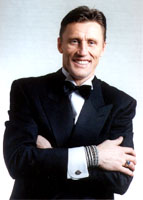

Borje Salming
Players' Category
During a rewarding career that spanned seventeen NHL seasons, Borje
Salming earned a place as one of the best two -way defencemen in the
game. He was the first European-trained player to make a significant
impact in the league. Salming's accomplishments and longevity in the NHL
helped pave the way for many subsequent European stars.
|
|
Born in Kiruna, Sweden on April 17, 1951, Salming spent his formative
years with the Kiruna AIF junior club. He was considered proficient
enough to represent his area in the national TV-Puck junior competition
and skate on the Swedish National Junior Team. In 1968 he helped the
Swedes take second place at the Junior European Cup tournament in West
Germany. Throughout this period Salming was heavily influenced by his
brother Stig who was also a top player for Sweden.
Salming then moved up to the Gavle-based Brynas club of the Swedish
Elite League. He excelled on the blueline of this team and helped them
win the league championship in 1971 and 1972. He also acquired valuable
experience with the Swedish "B" Team, known as the Vikings, and
eventually with the "A" Team, known as the "Tre Kronor". Salming debuted
in the colours of the latter on September 11, 1971 in a match against
Czechoslovakia in Stockholm. He later represented his country at the
1972 and 1973 World Hockey Championships. In 1973 it was Salming's
spectacular goal in the medal round match versus Finland that gave
Sweden the victory it needed to clinch the silver medal. Following the
1972-73 season he was chosen the outstanding player in Sweden.
|
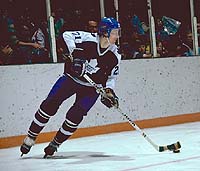 While he was at the peak of his domestic career Salming was noticed by
Toronto Maple Leafs' scout Gerry McNamara. During an exhibition match
against the touring Barrie Flyers, Salming's stellar play and
unwillingness to back down impressed McNamara. On May 12, 1973 Salming
and compatriot Inge Hammarstrom agreed to join Toronto in what became an
historically significant move. In his rookie campaign of 1973-74 Salming
While he was at the peak of his domestic career Salming was noticed by
Toronto Maple Leafs' scout Gerry McNamara. During an exhibition match
against the touring Barrie Flyers, Salming's stellar play and
unwillingness to back down impressed McNamara. On May 12, 1973 Salming
and compatriot Inge Hammarstrom agreed to join Toronto in what became an
historically significant move. In his rookie campaign of 1973-74 Salming
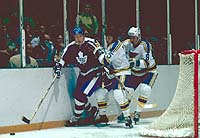 accumulated a respectable 39 points but more importantly handled the
rough side of the NHL quite easily. At the end of the season he was the
recipient of the inaugural Molson Cup based on points accumulated via
the three star selection after each game. Salming won this trophy four
out of the first seven years it was presented.
accumulated a respectable 39 points but more importantly handled the
rough side of the NHL quite easily. At the end of the season he was the
recipient of the inaugural Molson Cup based on points accumulated via
the three star selection after each game. Salming won this trophy four
out of the first seven years it was presented.
|
|
By his second NHL campaign he was among the NHL's elite blueliners.
Salming's exemplary play as a sophomore earned him selection to the NHL
Second All-Star Team.
|

 Salming combined remarkable puck handling skills with superior defensive
play and became one of Toronto's most respected and popular players. In
1976 he appeared in his first of three consecutive NHL All-Star Games. A
measure of Salming's immense popularity was clearly evident at the
inaugural Canada Cup tournament in 1976. During the player introductions
prior to the Canada vs. Sweden game, Salming received a louder ovation
than anyone on the Canadian squad.
He was brilliant throughout the tournament and was chosen to the Canada
Cup All-Star Team.
Salming combined remarkable puck handling skills with superior defensive
play and became one of Toronto's most respected and popular players. In
1976 he appeared in his first of three consecutive NHL All-Star Games. A
measure of Salming's immense popularity was clearly evident at the
inaugural Canada Cup tournament in 1976. During the player introductions
prior to the Canada vs. Sweden game, Salming received a louder ovation
than anyone on the Canadian squad.
He was brilliant throughout the tournament and was chosen to the Canada
Cup All-Star Team.
|
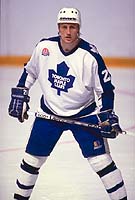
 During the 1980's Salming reached a number of milestones while serving
as the elder statesman on the Toronto blueline. On January 4, 1988 he
became the first European player to appear in 1,000 NHL games. Following
his last year in Toronto in 1988-89, Salming stood as the club's career
leader in assists and goals by a defenseman.
During the 1980's Salming reached a number of milestones while serving
as the elder statesman on the Toronto blueline. On January 4, 1988 he
became the first European player to appear in 1,000 NHL games. Following
his last year in Toronto in 1988-89, Salming stood as the club's career
leader in assists and goals by a defenseman.
Salming joined the Detroit Red Wings as a free agent in 1989-90 where he
added stability and experience to the club's blueline corps. At the
conclusion of that season he left the NHL but continued his professional
career with AIK Solna of the Swedish Elite Division. He remained with
the club until the early stages of the 1992-93 season when he brought
his distinguished playing days to an end.
|
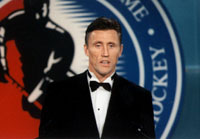
 In 1,148 NHL regular season games spread over seventeen seasons, Salming
totalled 150 goals and 787 points. He also accumulated 12 goals and 49
points in 81 Stanley Cup Playoff games. He was voted on to the NHL First
All-Star Team once and the NHL Second All-Star Team on five occasions.
Twice he was runner-up in the voting for the James Norris Trophy as the
NHL's top defenseman. In 1976, 1977 and 1979 he was the recipient of the
Viking Award as the top Swedish player in the NHL/WHA as chosen by a
poll of players from his own country. On the international stage he
represented Sweden with distinction at the 1976, 1981 and 1991 Canada
Cups. He also participated in the World Hockey Championships in
1972,1973,1982 and 1989.
In 1,148 NHL regular season games spread over seventeen seasons, Salming
totalled 150 goals and 787 points. He also accumulated 12 goals and 49
points in 81 Stanley Cup Playoff games. He was voted on to the NHL First
All-Star Team once and the NHL Second All-Star Team on five occasions.
Twice he was runner-up in the voting for the James Norris Trophy as the
NHL's top defenseman. In 1976, 1977 and 1979 he was the recipient of the
Viking Award as the top Swedish player in the NHL/WHA as chosen by a
poll of players from his own country. On the international stage he
represented Sweden with distinction at the 1976, 1981 and 1991 Canada
Cups. He also participated in the World Hockey Championships in
1972,1973,1982 and 1989.
|